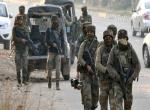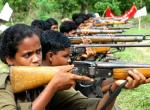It is untrue to consider Left-wing Extremism as purely local and self-sustaining. The extent of external linkages of the Indian Maoists is vast. The actors with which Naxals have linkages include Maoists of Nepal, militant groups operating in the northeast India, anti-Indian actors – state and non-state – based in Pakistan, and umbrella organisations at regional and global levels. The motives for the linkages are wide-ranging: to procure different varieties of arms, obtain training assistance, strengthen finances, trade drugs, ideological affinities, and to forge a broad front against the “common enemy” – India – in achieving the overall objective of capturing state power. Contextualising and justifying external linkages within the Maoist thought, the Naxals hold that
There are two different kinds of United Fronts. One, between people, and the other between people and enemy (a section/group/persons from enemy classes) using the contradictions among the enemy. [Maoist] Party has to do that. This scope is there to some extent on some issues. We call it the indirect reserves of the revolution which can be used carefully. If we have clear understanding that they are not our class allies, then we would not have right opportunist deviations. We need united fronts of this kind for the success of the revolution.1
The Indian Maoists have of late been found more than suitable for its agenda by the Inter-Services Intelligence (ISI), in its attempts to rope-in India-based militant groups. The overall intention of the ISI is to give an impression to the outside world that all terror attacks in India are home-grown.2 Indo-Nepal and Indo-Bangladesh borders are used extensively by the Pakistan-based Islamic groups as transit routes to reach out to Naxals. At the same time, Naxals are somewhat cautious in their liaison with jihadist groups because of long-term consequences. Therefore, the Naxal leadership is said to be in favour of “specific and need-based exchanges’’ with these groups that could be restricted to “consequential solidarity”. 3 The Maoists are aware of the fact that if the LeT-Maoists alliance is comprehensive and deep, it would be easier for the Indian state to club LWE also under anti-terrorism and respond accordingly. Naxals would not wish such a state response that could be more ruthless than the present “holistic” one. At the end of the day, ideology and objectives of these groups are quite different. However, even limited cooperation is a cause for concern, as Naxals are desperately looking outwards to enhance their military potential vis-à-vis the Indian state’s ongoing military push.
Naxal dominated areas are not only rich in minerals, but also popular drug cultivating tracts (cannabis and poppy in particular) in the states of Madhya Pradesh, Maharashtra, Chhattisgarh, Bihar, Jharkhand, Orissa and Andhra Pradesh. Apart from being world's largest producer of licit opium and the only authorised user of the gum method of opium production for pharmaceutical preparations, India is also sandwiched between ‘Golden Crescent’ and ‘Golden Triangle’, the two major drug producing and trafficking regions of the world.4 This geo-economic factor has not only helped Maoists to collect protection money from drug cultivators, traders and traffickers, but also to involve themselves directly in drug-trafficking. This is evident in seizure of large contrabands of marijuana that was being brought from states and specifically areas which are Naxal-infested.5 They are the latest entrants in this trade to fund their activities. Drugs like marijuana from Naxal areas are found for street sale even in remote areas of southern states like Kerala. The marijuana cultivated in the Naxalite-dominated forests bordering Orissa and Andhra Pradesh (called “Sheelavathi” in local name) is said to have higher tetrahydrocannabinol content, a psychoactive compound, than that of locally produced drugs (called locally as “Neelachadayan”). These drugs are peddled by Naxal-linked middlemen in large quantities by rail and road, including on buses conducting inter-State services. 6
Despite in ceasefire mode and under UN monitoring, the Nepali Maoists have been extending “full support and cooperation” to their counterparts of India not only on ideological basis but also for arms procurement, drugs trade, training and resource mobilisation. 7 The Maoists on both sides of borders have also formed the Indo-Nepal Border Region Committee to coordinate their activities in North Bihar and along the India-Nepal border. Porous open border between India and Nepal has facilitated smooth coordination between the groups.8 The People’s Liberation Army, the military wing of the Communist Party of Nepal (Maoists), has been involved in providing military training and bomb making to sections of Naxalites. 9 The Lashkar-e-Toiba operatives are also said to be involved in the training, especially in the use of IEDs, in Maoists-run camps of Nepal.10
Till recently, Naxals had working relations with the Liberation Tigers of Tamil Eelam (LTTE) especially on training. When the LTTE was active and fighting for Eelam in the northeast of Sri Lanka, it regularly supplied arms and ammunition to Naxal groups delivered mostly at the coasts of Andhra Pradesh. 11 Naxals came to know of the LTTE through the Tamil Nadu Communist Party-Marxist-Leninist (TNCP-ML) that was formed in 1984-85 after a split between Communist Party of India – Marxist Leninist (CPI-ML) and its Tamil Nadu unit.
The Indian Maoists have good network with several key militant groups of the northeast India. In fact, with some groups, the exact modalities of working – formal, semi-formal and informal – are spelled out through “memoranda of understanding”. The Naxals get arms and training from the northeast militant groups like National Socialist Council of Nagaland (NSCN-IM), United Liberation Front of Asom (ULFA), People’s Liberation Army (PLA), People’s Revolutionary Party of Kangleipak (Prepak), Revolutionary People’s Front (RPF), Kamtapur Liberation Organisation (KLO), Gorkha Liberation Tiger Force (GLTF), Gurkha Liberation Organisation (GLO), Adibasi National Liberation Army and National Democratic Front of Bodoland (NDFB). Chinese small arms find their way to the ‘Red Corridor’ mainly through the northeast militant groups.12 The mutual support between Naxals and northeast militant groups is not just restricted to material, but extends to moral aspects as well. While Naxals have strongly supported “people’s movements” of the northeast, the northeast militant groups have stood by “revolutionaries”. “Enemy’s enemy is a friend” is the guiding maxim in this case as well. It is through the northeast groups the Maoists have good access to militant groups of Myanmar. There are also attempts by the Naxals to set up support bases in tea garden areas in upper Assam and some of the tribal areas in the hilly interiors. Presently, the Krishak Mukti Sangram Samiti of Assam is working as a front of Maoists in Assam. 13
According to Maoists “it is important for the success of the Indian revolution as an inseparable part of great world socialist revolution to actively defend Maoism, fight imperialism and support the class struggle throughout the world and also take the support of the International Maoist Parties/Organizations/Forces, proletariat and people.”14 It is for this purpose they maintain fraternal relations with Maoist and “anti-imperialist forces” through several umbrella organisations that exist at regional and global levels.
Prominent among them is CCOMPOSA (Coordination Committee of Maoist Parties and Organisations of South Asia), formed in July 2001, with a purpose to unify and coordinate the activities of “genuine” Maoist parties and organisations in South Asia. The present constituent parties of CCOMPOSA are, apart from CPI (Maoists), Purbo Banglar Movement (Bangladesh), Communist Party of Ceylon (Sri Lanka), United Communist Party of Nepal (Maoist), Poorba Bangladesh Sarvahara Party (CC), Communist Party of East Bengal (ML), Red Flag Communist Party of Bhutan(MLM), Communist Party of India (MLM), and Communist Party of India (ML) (Naxalbari). The CCOMPOSA members have agreed to share each others’ experiences and strengthen one another in “fighting back the enemies in the respective countries” and “making South Asia a blazing center of world revolution.”15 The aim of the organisation was identified to “develop mass movements against the common enemy, i.e. Indian Expansionism, the world imperialist system, particularly US imperialism, the No. 1 enemy of the world people; and to overthrow the existing system in the countries of South Asia.”16 Conferences are held from time-to-time to take stock of the situation and plan responses. So far, only five such conferences have been held since the formation of the body – once in two years on an average. However, CCOMPOSA received a setback with the Nepali Maoists joining political mainstream renouncing violence.
At the global level, FOIR is an important umbrella organisation whose representatives abroad seek to raise finances in several countries, especially that of the West, for the “cause” of the Indian “revolution”. Then there are bodies like International Conference of Marxist-Leninist Parties and Organisations (ICMLPO), Revolutionary Internationalist Movement (RIM), World People’s Resistance Movement (WPRM) and International Communist Movement (ICM) that link LWE groups located all over the world stretching from Peru in the West to Philippines in the East. They sustain fraternal ties and jointly conduct programmes that are mutually beneficial.17 This does not mean that the Maoists are unanimous in their opinion on linkages with international communist movements. For instance, before the merger of Maoists Communist Center (MCC) and People’s War Group (PWG) to form CPI (Maoists), the MCC had joined RIM in 2002, but the PWG opposed the idea. After the merger, the MCC pulled out of RIM as per the decision of the new Party. The RIM went out of action anyway.
Reference :
- Interview with Ganapathy, the General Secretary of the CPI (Maoists), by Jan Myrdal and Gautam Navlakha, January 2010, accessed on 20 April 2011.
- Sandeep Unnithan, “Karachi Project,” India Today, 18 February 2010.
- Anupam Dasgupta, “LeThal enemy,” The Week, 17 April 2011
- Bureau of International Narcotics and Law Enforcement Affairs, International Narcotics Control Strategy Report (INCSR)-2011, Vol. 1, 03 March 2011, p. 301.
- “Drug menace: Narcotics Control Bureau tightens screw,” Daily News & Analysis, 06 April 2011.
- Ganja trail leads to Naxal belt,” The Hindu, 24 August 2010.
- “Nepal Maoists admit link with Indian Naxals,” The Times of India, 03 November 2009
- “For Naxals, the Bihar-Nepal border is line of no control,” The Indian Express, 26 August 2004.
- “India ‘concerned’ over Nepal Maoists’ link with Naxalites,” Hindustan Times, 06 November 2010.
- “Let send Nepal conduits to build Naxal links,” The Indian Express, 28 May 2010.
- “LTTE, Naxal tryst on high seas,” The Times of India, 17 June 2004.
- “Security forces recover Chinese arms from Naxals, militants,” Daily News & Analysis, 16 November 2009.
- “Cornered Naxals are cozying up to NE ultras,” Rediff News, 25 February 2011.
- Interview with Ganapathy, the General Secretary of the CPI (Maoists), by Jan Myrdal and Gautam Navlakha, January 2010, accessed on 20 April 2011.
- Press Release of 5th Conference of CCOMPOSA, 23 March 2011, accessed on 25 May 2011.
- Press Statement of CCOMPOSA, People’s March, Vol. 4, No. 8, August 2003.
- “Support for Naxals goes global,” People’s Review, 24 February 2011.
Author is Senior Fellow at Vivekananda International Foundation
Published Date : 28th March, 2012









Post new comment